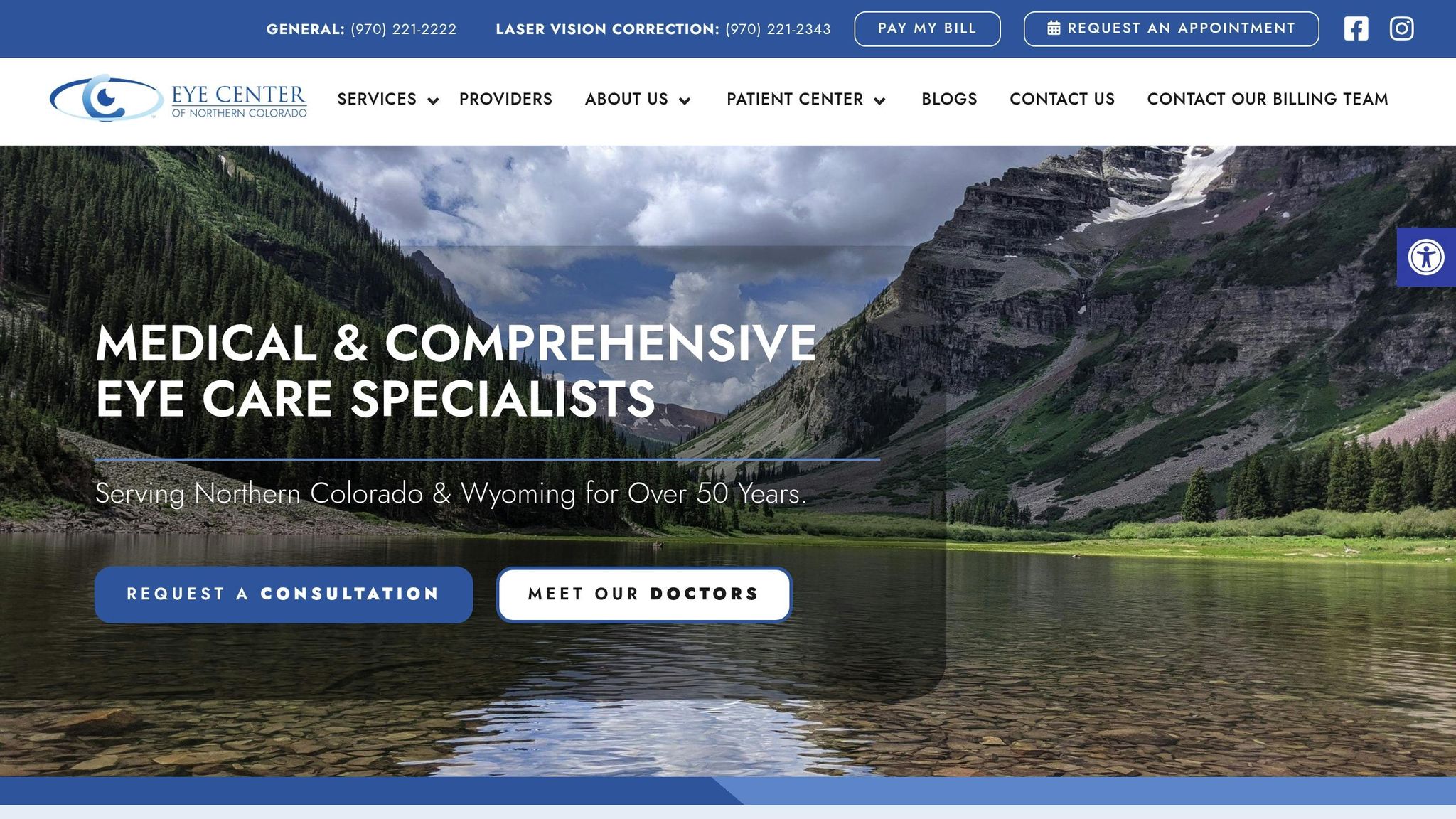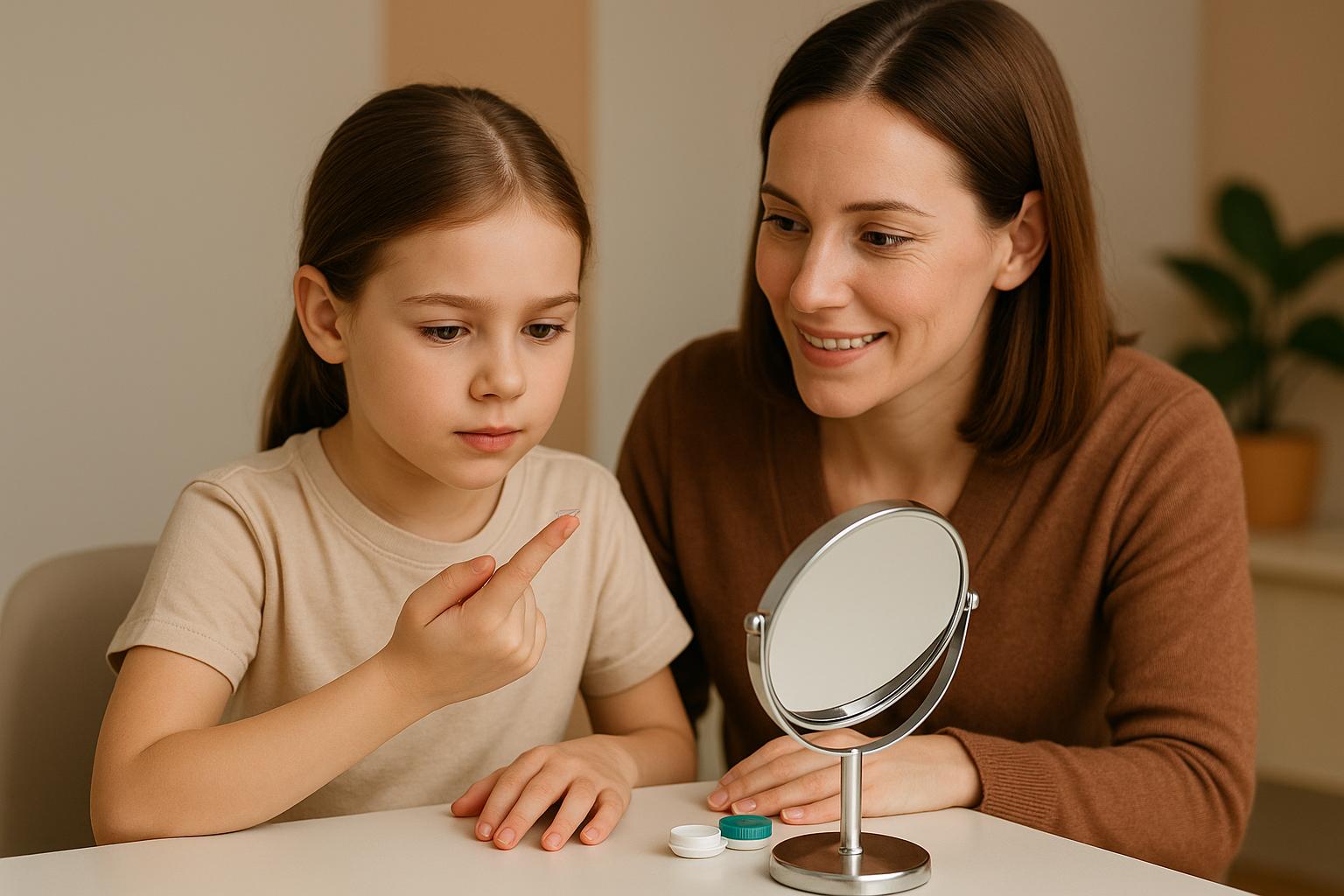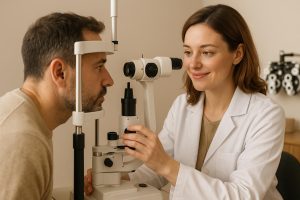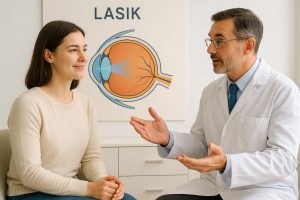Children as young as 8 years old can safely wear contact lenses, but readiness depends more on their maturity and responsibility than their age. Key factors include:
- Maturity: Can your child handle hygiene and follow multi-step instructions?
- Lifestyle: Active kids or those involved in sports may benefit from contact lenses over glasses.
- Vision Needs: Conditions like myopia or astigmatism may make contacts a better option.
- Parental Supervision: Younger children often need help managing lens care.
Daily disposable lenses are a great starting point for kids under 12, as they reduce infection risks and simplify care. For myopia control, FDA-approved options like MiSight® lenses are available for children aged 8–12. Regular eye exams and professional guidance are essential to ensure safety and proper fit.
What age can my child start wearing contact lenses? | Ask Dr. Kwan
How to Tell if Your Child is Ready
Determining if your child is ready for contact lenses is less about their age and more about their maturity. Eye care professionals prioritize maturity and responsibility when evaluating whether a child can handle the commitment and care required for contact lenses. A child who consistently demonstrates self-care and follows instructions is far more likely to succeed with contact lenses than one who struggles with daily routines.
Maturity and Responsibility Signs
One of the clearest indicators of readiness is your child’s ability to manage personal care independently. Good personal hygiene is a strong sign to look for. If your child regularly washes their hands without being reminded, keeps their face clean, and practices good oral hygiene, they may already have the discipline needed to care for contact lenses properly.
Other key habits include handling personal items with care and completing tasks without constant supervision. For example, if your child frequently loses their glasses or forgets basic hygiene practices, they may not yet be ready for the added responsibility of contact lenses.
Children who are ready for contact lenses typically excel at following multi-step instructions. They should also show responsibility in their daily routines, such as getting ready for school, completing homework on time, or doing chores without repeated reminders. These behaviors reflect the ability to manage the demands of contact lens care effectively.
Interestingly, research supports the idea that age is less critical than maturity. A three-year study involving 294 children aged 7-11 showed that contact lenses can be just as safe for children as for adults, provided proper supervision is in place. This highlights how a child’s readiness depends more on their behavior than their age.
Additionally, eye care professionals often assess a child’s motivation to wear contact lenses during appointments. Children who are genuinely interested in contacts and understand the responsibilities involved are more likely to succeed. In contrast, those who feel pressured by parents or peers may struggle.
Age Guidelines
After confirming signs of maturity, age can serve as a helpful guideline for deciding if your child is ready for contact lenses. Most eye care professionals agree that children as young as 8 years old can safely use contact lenses if they demonstrate the necessary responsibility. However, the ideal age range is typically 10-12 years old, as children in this group are usually better equipped to follow care routines and understand the importance of lens hygiene.
Statistics from the American Optometric Association show how contact lens use grows with age: 2% of children under 9 wear contacts, 7% of children aged 10-12, 13% of those aged 13-14, and 19% of teens aged 15-17. These figures reflect the natural progression of maturity as children grow older.
In exceptional cases, children as young as 6 or 7 years old have successfully worn contact lenses, often with close parental supervision and specific needs, such as significant vision correction or participation in sports.
Additionally, FDA-approved daily disposable contact lenses for myopia control are now available for children starting at age 8. These lenses offer an option for younger children who need vision correction to help slow the progression of nearsightedness.
Research also supports the safety of contact lenses for children when proper care and supervision are provided. A six-year international study of 144 children wearing daily disposable lenses found that only three discontinued use due to eye-related issues, and no serious complications were reported. This underscores that with the right guidance, contact lens use can be a safe choice for children.
Parental involvement is essential, especially in the early stages. Even the most mature children benefit from support as they learn how to insert, remove, and care for their lenses. With consistent practice and encouragement, most children master these skills within a few days to a week. Supervision during this learning period can make all the difference.
Medical and Lifestyle Factors
In addition to age and maturity, medical and lifestyle factors play a key role in determining whether contact lenses are a good option. These factors often complement the age and maturity guidelines mentioned earlier.
Vision Problems That May Need Contacts
Contact lenses can be a game changer for children with specific vision issues like myopia (nearsightedness) and astigmatism. For kids with high prescriptions, contacts often provide better clarity and comfort than glasses.
Myopia is becoming increasingly common in children, making contacts a practical solution for many families. Certain FDA-approved lenses have even been shown to slow the progression of myopia, offering long-term benefits.
For children with astigmatism, glasses can sometimes be uncomfortable or inconvenient – especially if they’re heavy or prone to slipping down the nose. Contact lenses eliminate these issues, offering stable and clear vision correction. They’re also a great alternative for kids with high prescriptions, as they avoid the distortions that glasses can sometimes cause.
However, some medical conditions may make contact lens wear less suitable. Chronic eye infections, severe allergies, dry eye syndrome, or poor tear production can pose risks. Additionally, children who frequently rub their eyes or struggle with hygiene routines might need to develop better habits before starting with lenses.
Sports and Physical Activities
For kids who are active or play sports, contact lenses offer a clear advantage over glasses. They provide a broader field of vision and won’t fog up, slip, or fall off during games. This makes them particularly appealing for young athletes participating in sports like soccer, basketball, gymnastics, or even swimming – though swimming with lenses requires special care.
Contacts can also be worn with protective sports goggles, making them a flexible option. Daily disposable lenses are often recommended for sports because they reduce the risk of infection, especially in environments where dust, sweat, or frequent face-touching is common. For swimming, most eye care professionals recommend removing lenses unless a doctor advises otherwise and proper precautions are taken.
Why Eye Exams Matter
A thorough eye exam is essential to determine if your child is ready for contact lenses. These exams go beyond a standard eyeglass prescription, focusing on factors like corneal curvature, tear film quality, and overall eye health. A specialized exam ensures that the lenses fit correctly and meet your child’s vision needs.
Eye care professionals also look for any conditions that might make contact lens wear unsafe. Regular checkups are critical since children’s vision can change quickly.
The Eye Center of Northern Colorado provides comprehensive pediatric eye exams, personalized consultations, and detailed guidance on contact lens care. Their team of fellowship-trained ophthalmologists and optometrists evaluates each child’s vision and medical suitability for lenses. They also offer trial fittings, where children can practice inserting and removing lenses under professional supervision. This hands-on approach ensures a proper fit and promotes safe, long-term lens use.
Routine eye exams become even more important once your child starts wearing contact lenses. Follow-up visits help confirm that the lenses continue to fit well, the eyes remain healthy, and any vision changes are addressed promptly. These ongoing evaluations are key to selecting the right lenses and maintaining good eye health over time.
sbb-itb-5ef6ec9
Types of Contact Lenses for Children
Selecting the right contact lenses for your child depends on their level of responsibility and specific vision needs. Each type of lens comes with its own set of advantages and care requirements.
Daily Disposable vs. Other Types
Daily disposable lenses are a popular choice for kids, especially those under 12. They don’t require cleaning routines, which reduces the risk of infections. Research shows that most 8-year-olds can learn to insert and remove daily disposables on their own. These lenses also help prevent buildup, making them a safer option for younger children.
On the other hand, biweekly and monthly soft lenses are more budget-friendly but demand daily cleaning and storage. Because of this, they are better suited for older kids, typically over 12, who can handle the responsibility. It’s worth noting that about 5% of contact lens users experience complications annually, often due to improper care.
For children with more complex vision needs, rigid gas permeable (RGP) lenses might be an option. These lenses are durable and effective for conditions like high astigmatism or irregular corneas. However, they require careful handling and a longer adjustment period, so they’re usually prescribed only when medically necessary.
Next, let’s look at specialized lenses designed to manage myopia.
Special Lenses for Myopia Control
For children dealing with myopia, there are lenses specifically designed to slow its progression. MiSight® 1 day is currently the only FDA-approved daily disposable lens proven to reduce myopia progression in kids aged 8–12 at the start of treatment. These lenses use dual-focus technology to alter how light is focused on the retina, which helps slow eye growth. In a 6-year clinical study, MiSight® 1 day was shown to be both safe and effective in managing nearsightedness.
Another option is orthokeratology (Ortho-K) lenses, which are worn overnight to gently reshape the cornea. While effective, Ortho-K lenses require meticulous care and are generally recommended for older children who can manage the responsibility.
At the Eye Center of Northern Colorado, families can access these advanced myopia control options as part of comprehensive pediatric eye care services, ensuring children receive cutting-edge solutions for managing nearsightedness.
Contact Lens Comparison Chart
| Lens Type | Comfort | Maintenance | Monthly Cost | Infection Risk | Best Age Group |
|---|---|---|---|---|---|
| Daily Disposable | High | Minimal (discard daily) | ~$60–$120 | Lowest | Ages 8–12+ |
| Biweekly/Monthly Soft | High | Moderate (nightly cleaning) | ~$30–$80 | Higher | Ages 12+ |
| Rigid Gas Permeable (RGP) | Moderate initially | High (requires careful handling) | Higher initial investment* | Moderate | Ages 10+ (specific needs) |
| Myopia Control (e.g., MiSight® 1 day) | High | Minimal (daily disposable) | Costs vary* | Lowest | Ages 8–12 |
*Note: RGP lenses often involve a higher upfront cost due to their durability, while the price of myopia control lenses can vary depending on the technology and insurance coverage.
For most kids, daily disposables strike the perfect balance between safety, convenience, and comfort. They’re an excellent option for young athletes or children with active lifestyles who might struggle to maintain proper lens care routines.
Benefits and Risks of Contact Lenses for Kids
When considering contact lenses for children, it’s essential to weigh the positives and potential downsides. This helps parents make the best choice for their child’s vision and lifestyle.
Main Benefits of Contact Lenses
Contact lenses come with several perks for kids. They offer clear, natural vision without the hassle of eyeglass frames. For children with stronger prescriptions, contacts often provide a more comfortable and natural visual experience compared to thick glasses. Many kids also report feeling more confident without frames on their face.
For active children, contact lenses are a game-changer. They stay in place during movement, offer better peripheral vision, and eliminate worries about glasses breaking or getting lost during sports or play. Simply put, they’re a practical and confidence-boosting option for kids on the go.
Possible Risks and Safety Tips
Though generally safe when used properly, contact lenses do come with some risks. The biggest concern is eye infections, which typically result from improper cleaning or storage of lenses. Research shows that children experience corneal infiltrative events (a type of eye complication) at rates similar to or even lower than adults. For example, a six-year international study of 144 kids using daily disposable lenses found only three cases where lens use was discontinued due to minor issues, with no serious complications reported .
Parental involvement is key to minimizing these risks. Parents should ensure their child follows proper hygiene, handles lenses carefully, and sticks to the recommended wear schedule. Daily disposable lenses are often the best choice for kids under 12, as they reduce the risk of contamination. Other tips include teaching kids not to share lenses, monitoring their lens care routine, and scheduling regular eye exams to keep tabs on their eye health.
Benefits vs. Risks
Here’s a quick breakdown of the advantages, risks, and safety measures:
| Benefits | Potential Risks | Safety Measures |
|---|---|---|
| Clear vision without eyeglass frames | Eye infections from poor hygiene | Use daily disposable lenses and maintain proper cleaning routines |
| Boosts self-esteem and confidence | Issues from improper lens care | Supervise lens use and educate kids on proper care |
| Better performance in sports and active play | Corneal complications (e.g., infiltrative events) | Follow wear schedules and attend regular eye exams |
When proper precautions are taken, the benefits of contact lenses often outweigh the risks. Studies show that complications occur in only about 5% of wearers annually, with most issues tied to poor hygiene or misuse. On top of that, research reveals that 90% of kids aged 8–12 can successfully insert and remove daily disposable lenses on their own.
At the Eye Center of Northern Colorado, families are supported every step of the way – from the initial fitting to ongoing care – ensuring that children can safely enjoy the many perks of contact lenses.
Next Steps for Parents
What to Remember
Deciding whether contact lenses are right for your child isn’t just about their age – it’s about their maturity and responsibility. Kids who can consistently follow instructions, practice good hand hygiene, and take care of their personal needs are usually ready to handle contact lenses.
For children under 12, daily disposable lenses are often the best option. These lenses remove the need for cleaning routines and reduce the risk of infections. Start with a thorough eye exam and keep a close watch during the early days of lens use. If your child has myopia, consider asking about FDA-approved myopia control lenses like MiSight, which have been shown to slow myopia progression by nearly 50% in kids aged 8–12.
It’s also a good idea to prepare a spare lens kit for school or activities and let your child gradually increase their lens wear time as they adjust. Setting a positive example with your own lens care habits can make the process smoother for them. Once you’ve covered these basics, seeking professional guidance is the next step.
How the Eye Center of Northern Colorado Supports Families

Getting expert help can make the transition to contact lenses much easier. The Eye Center of Northern Colorado has been providing pediatric eye care for over 50 years, serving families across Northern Colorado and Wyoming. Their team of fellowship-trained ophthalmologists and optometrists tailors care to meet each child’s individual needs.
During a consultation, their specialists will determine if your child is ready for contact lenses, perform a detailed eye exam, and offer personalized lens fittings. They also provide hands-on training for both kids and parents, ensuring everyone feels confident about proper lens care and hygiene. Plus, they offer access to the latest lens technologies, including myopia control lenses like MiSight.
"Everyone very friendly, very helpful, and very professional. All my questions were answered." – Carol Torrey, November 18, 2025.
The Eye Center also emphasizes regular follow-ups to monitor your child’s eye health and ensure their lenses continue to fit well. With multiple locations across Northern Colorado and Wyoming, ongoing support is convenient and accessible.
Ready to take the next step? Schedule a consultation to explore whether contact lenses are a good fit for your child and your family.
FAQs
How can I tell if my child is ready for contact lenses?
Determining whether your child is ready for contact lenses comes down to assessing their maturity and how well they handle responsibilities. Key indicators include consistently practicing good hygiene, following instructions without reminders, and managing daily tasks on their own. Since contact lenses require careful handling and maintenance, your child needs to show they can manage these responsibilities safely.
You’ll also want to think about your child’s eye health and day-to-day activities. Contact lenses can be a great option for kids who play sports or participate in activities where glasses might get in the way. To make the best choice, schedule an eye exam with a qualified eye care professional, like the experts at the Eye Center of Northern Colorado. They can evaluate your child’s vision and provide tailored advice based on their needs.
Are contact lenses a good option for kids who play sports?
Contact lenses can be a fantastic choice for kids who are active in sports. Unlike glasses, they won’t fog up, slide down, or risk breaking during a game. Plus, they offer a wider field of vision, which can make a big difference in fast-paced sports like basketball or soccer.
That said, it’s essential to make sure your child is ready to take on the responsibility of wearing and caring for contact lenses. Regular visits to an eye care professional – such as those at the Eye Center of Northern Colorado – can help determine if contact lenses are a good match for your child’s needs and lifestyle.
What steps can parents take to ensure their child safely uses contact lenses?
To help your child use contact lenses safely, the first step is to consult an eye care professional. They’ll determine if contacts are suitable based on your child’s age, maturity, and eye health. From there, teaching proper hygiene is crucial – make sure your child knows to wash their hands thoroughly before handling lenses and to follow the cleaning and storage instructions carefully. Routine eye exams are equally important to keep track of their eye health and ensure the lenses continue to fit properly.
It’s also essential to stress the importance of sticking to the prescribed wearing schedule. Unless specifically approved by their doctor, your child should never sleep in their lenses. Encourage open communication – let them know they should tell you or their eye doctor right away if they notice discomfort, redness, or changes in vision. By helping your child develop these responsible habits, you can ensure they enjoy the convenience of contact lenses while keeping their eyes healthy.





